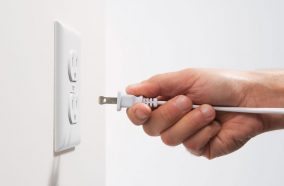
Electrical Safety in your Home
Electrical safety involving outlets, plugs and extension cords is one of the most important home safety issues. U.S. fire departments respond to an average of 47,820 structure fires a year involving an electrical fire or malfunction, but there are steps that homeowners and tenants can take to help prevent electrical fires.
From tamper-resistant receptacles to GFCI (Ground Fault Current Interrupter) outlets, there are now safer electrical options that you might want to consider including in your home. The following are some safety tips for you to consider when using electrical outlets, electrical cords and extension cords.
Outlet Safety Tips
Homes built before 1965 typically have ungrounded two-pronged outlets, while newer construction will usually have three-pronged outlets, which include a hot, neutral and ground wire. Homeowners may want to consider upgrading their wiring to accept three-pronged outlets, particularly if you are replacing older outlets that may be cracked, damaged or covered in paint.
- Turn off appliances before unplugging them to avoid a “hot unplug,” which can result in an arc inside that could create a fire hazard.
- Install tamper-resistant (TR) receptacles in outlets near where children will be present. These outlets contain an internal spring-loaded shield that requires even pressure on both sides of the outlet to access the electrical contacts. The National Electric Code® has required new and renovated dwellings to include TR receptacles since 2008.3
- When plugging an appliance into a receptacle outlet, make sure you read and follow the manufacturer’s instructions.
- Only one high-wattage appliance should be plugged into a receptacle outlet at a time.
- Only one heat-producing appliance, such as a toaster or coffee maker, should be plugged into a receptacle outlet at a single time.
- To help protect against shock hazards, make sure you install ground-fault circuit interrupters (GFCIs) in the kitchen, bathroom, laundry room, basement, garages, outdoor areas and other places where electrical equipment is near water or can get wet. A GFCI can either be installed in your electrical system or built into a power cord to help prevent severe shocks.
- To help prevent fires, have a qualified electrician install arc-fault circuit interrupters (AFCIs), which can help protect against fires that result from problems in home wiring, such as arcing and sparking.
Power and Extension Cord Safety Tips
Be aware of the fire risk that damaged power cords pose, and the fact that extension cords are only intended for temporary use. Consider having a qualified electrician add additional circuits or outlets so you do not have to use extension cords.
- Replace or repair damaged or loose electrical cords as they can increase the risk of electrical shock or cause arcing or overheating, which can lead to a fire.
- Do not use an extension cord with major appliances.
- Do not run extension cords under carpets.
Other Safety Tips
- Never place anything that can burn (e.g., towels, scarves) over a lamp or heat-producing appliance.
- Remember to use lightbulbs with the correct wattage to help prevent overheating.
Call a Qualified Electrician if You Have:
- Warm-to-the-touch wall outlets or switches.
- Fuses that regularly blow or circuits that often trip.
- Appliances that smell rubbery or as if they are burning.
- Lights that dim or flicker.
- Appliances that spark.
Comments
There are no comments yet.



